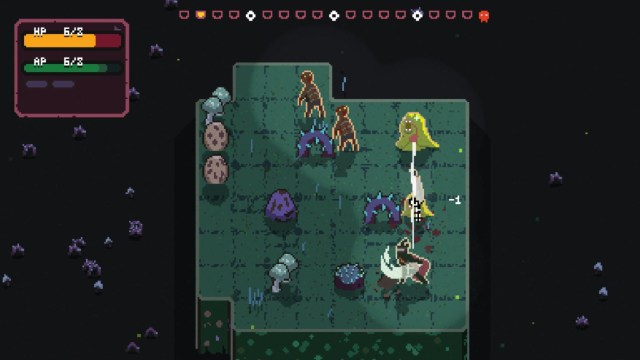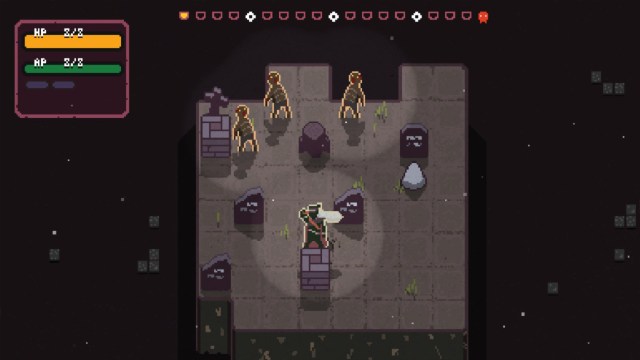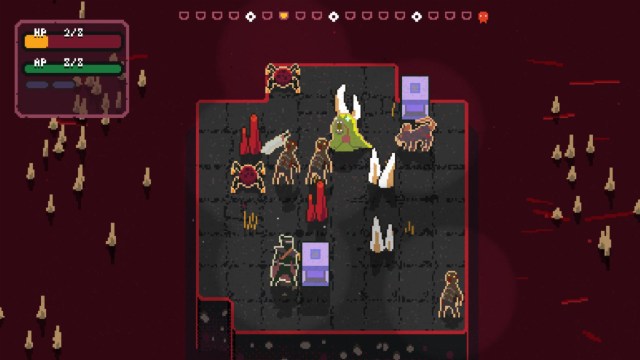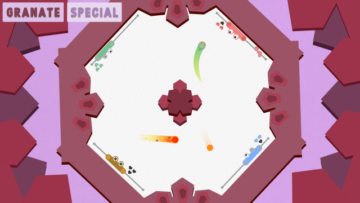Have you ever loved a game, but utterly failed at being good at it? Like a masochist, you keep playing it and failing, over and over, whacking into the glass pane like a bee? It’s the position we find ourselves in with Undergrave. We couldn’t tell you why we keep coming back to it, because it’s certainly not because we’re beating it.
Undergrave is a turn-based tactics game that is exquisitely minimalist. You are a kind of demon-killing ninja, wandering the depths of hell, and hell happens to be a series of square grids. On those grids spawn enemies, and you take it in turns to move and attack, move and attack, until someone emerges victorious. Then it’s onto the next square grid, and the next, before all your health runs out and the run is over. There’s an incredibly small chance that you make it further than you ever did before.


As you can probably guess from the description, Undergrave is a roguelike. Each run starts in the same way. You begin in a portal room, where you hop to the furthest world that you have unlocked. Having chosen your world, you begin the same loop of four turn-based battles, before entering a reward room and choosing a perk that makes you more powerful for later battles. This loop of battles and reward-room plays out three times over, before you are taken to the world’s boss. Defeat them, and a new world is unlocked. Something like progress is made.
The battles may be minimalist, but they still manage to be innovative. They reminded us a lot of Fights in Tight Spaces, which had a similar aim of stripping back the genre to become more accessible, while also conveying a street fight through playing cards in stop-start turns.
In each turn of Undergrave, you can choose from one of three actions. You can throw your sword, dash in one direction, or jump and land on a square. You can’t simply move a square in one direction: it has to be one of these moves. It makes you feel a bit like a knight in chess, as you are hugely maneuverable, but only in very specific ways, and not always in a manner that protects you from close-range harm.
Each move has positives and negatives. Take throwing your sword, for example. It’s the most reliable method of killing an enemy, and also one of the cheapest, as it only costs two AP – the action points that act as a currency in the game. But throwing your sword leaves you, unsurprisingly, without a sword. Suddenly you are vulnerable, and you have to find a way of getting the sword back quick-smartish.
The dash is a very specific length, and only in one direction. You absolutely muller anyone in your path, but they have to be in your path, and that makes it somewhat limited. The jump is insanely powerful – you can jump anywhere in the grid, killing anyone you land on – but it’s also expensive in terms of AP. Once you have jumped, there is a very good chance that you can’t afford a follow-up attack. You are a sitting duck.


Find the flows, the chains, between these attacks, and suddenly Undergrave comes into focus. Dash into a thrown sword and you pick it up immediately, allowing you to cut through an unwitting zombie. Kick a monster into your sword, and it will impale upon it. Jump next to an enemy and it will stun, leaving you time to dash through it on the next turn. The synergies available in Undergrave are subtly wild.
You’ll need to pick up all of these tricks if you want to survive. We died a ludicrous amount in the opening couple of hours, and that’s because Undergrave has zero interest in teaching you them. There’s no tutorial, and you have to learn by doing. It’s only then that you’ll realise that certain attacks flow into others. Once you’ve got a handle on how to deal with certain situations, you might actually win.
But don’t bet on it. Undergrave, even once you know a few maneuvers, is insanely difficult. We have got to the point now, after several hours, when we can be reasonably sure that we’ll reach the boss of a world…but we will very rarely beat them. They are absolute buggers, escalating in difficulty faster than we can keep up with, and wielding utterly unfair attacks. It’s only through luck and wisely chosen upgrades that we’ve ever tasted success.
The upgrades are fantastic, great fun to choose between, and annoyingly random. Every four levels you get to pick a perk, and they’re transformative. They will stun enemies for the first two turns of a battle, or nobble the end boss’s health. Others will work in concert with each other, lessening the price of a sword-throw while also boomeranging the sword back to you. But they are also drawn from a deck, so are completely random.
We found that certain benefits were borderline essential for particular bosses (we’re not sure the first boss could be beaten without halving his health and increasing the range of your attacks), yet you’re at the whims of RNG if you want them. Having low health, desperately needing a life-injection, but getting nothing of the sort from the upgrades is a pretty naff feeling.


There are the usual roguelike downsides, too. You have to wade through easier battles before you get to the more difficult ones, and that wading isn’t always fun. Once you git gud and find them on the easy side, they feel more like makework than a genuine challenge. And Undergrave doesn’t do a fantastic job of making your failures into successes. There’s no XP or meta-upgrades to unlock with each run, so losing on a run can often feel like a waste of time. You don’t end up feeling more likely to succeed next run.
Not that it deterred us. Undergrave is so elegant and minimalist that jumping into another run felt low effort. So, while we died in its turn-based battles over and over again, we never felt like rage-quitting. We’d have worked out another combo, another abuse of its three, simple attacks, and want to put it into action. Maybe – just maybe – that exploit would be enough to guarantee success. It’s a delusion, but one that kept us playing Undergrave. It kicked our ass, but showed just enough vulnerability to make us think that we could win.
- SEO Powered Content & PR Distribution. Get Amplified Today.
- PlatoAiStream. Web3 Data Intelligence. Knowledge Amplified. Access Here.
- Minting the Future w Adryenn Ashley. Access Here.
- Buy and Sell Shares in PRE-IPO Companies with PREIPO®. Access Here.
- Source: https://www.thexboxhub.com/undergrave-review/
- 1
- a
- Absolute
- absolutely
- abuse
- accessible
- act
- Action
- actually
- after
- again
- AI
- aim
- All
- Allowing
- also
- always
- amount
- an
- and
- Another
- anyone
- ARE
- as
- At
- available
- back
- Battle
- BE
- because
- become
- before
- begin
- being
- benefits
- bet
- between
- Bit
- but
- by
- CAN
- Cards
- certain
- certainly
- chains
- challenge
- chance
- Chess
- choose
- Choosing
- chosen
- comes
- coming
- completely
- content
- Costs
- could
- Couple
- Currency
- Cut
- Dash
- deal
- depths
- description
- desperately
- DID
- died
- difficult
- difficulty
- direction
- do
- doing
- drawn
- each
- easier
- easy
- effort
- emerges
- end
- enough
- entering
- essential
- even
- EVER
- Every
- Example
- expensive
- Exploit
- Failed
- failing
- faster
- feel
- few
- fight
- find
- First
- flow
- flows
- Focus
- For
- four
- from
- fun
- further
- game
- Genre
- genuine
- Get
- getting
- Git
- Glass
- good
- great
- Grid
- guarantee
- had
- handle
- happens
- harm
- has
- Have
- having
- Health
- his
- hours
- How
- How To
- HTTPS
- hugely
- if
- immediately
- in
- increasing
- incredibly
- innovative
- interest
- into
- Is
- IT
- ITS
- Job
- jpg
- jump
- just
- keep
- kept
- kick
- kind
- know
- Land
- later
- LEARN
- leaving
- levels
- like
- likely
- Limited
- losing
- lot
- loved
- Low
- Luck
- made
- make
- MAKES
- Making
- manage
- manner
- May
- Method
- might
- more
- most
- move
- need
- never
- New
- new world
- Next
- Ninja
- no
- not
- nothing
- now
- of
- often
- on
- once
- One
- ones
- only
- opening
- or
- Other
- Others
- our
- ourselves
- out
- over
- particular
- path
- pick
- plato
- plato data intelligence
- platodata
- platogaming
- Playing
- plays
- Point
- Points
- Portal
- position
- powerful
- pretty
- price
- probably
- Progress
- put
- range
- reach
- reliable
- review
- reward
- rng
- Roguelike
- room
- Run
- same
- Series
- several
- showed
- side
- similar
- Simple
- Simply
- Sitting
- situations
- small
- So
- someone
- something
- Spawn
- specific
- square
- still
- street
- succeed
- success
- survive
- sword
- tackle
- tactics
- Take
- taken
- Teaching
- tell
- terms
- than
- that
- The
- The Game
- Them
- then
- there
- These
- they
- think
- this
- those
- three
- Through
- time
- times
- to
- too
- transformative
- turn
- turns
- tutorial
- two
- Undergrave
- unfair
- unlock
- until
- up
- upgrades
- upon
- us
- very
- victorious
- vulnerability
- Vulnerable
- want
- waste
- way
- ways
- we
- were
- when
- where
- while
- why
- wild
- will
- win
- with
- without
- Work
- worked
- world
- Worlds
- would
- yet
- you
- your
- zephyrnet
- zero











